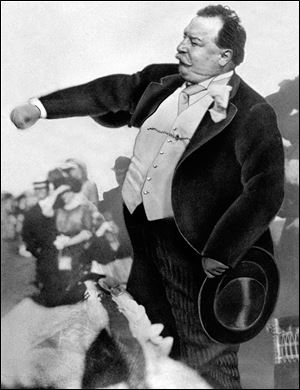
Taft’s tactics to shed fat frame 100 years ago quite familiar
Diet doc’s advice used for obese today
10/14/2013
President William Howard Taft, seen throwing the first pitch of a Washington Senators game in 1912, struggled mightily with obesity for decades. But he never gave up, and when he died in 1930, he weighed 280 pounds.
NEW YORK — William Howard Taft, the only massively obese man to be President of the United States, struggled mightily to control his weight a century ago, worrying about his health and image and enduring humiliation from cartoonists who delighted in his corpulent figure. But new research has found that his weight-loss program was startlingly contemporary, and his struggles to keep the pounds off would be familiar to many Americans today.
On the advice of his doctor, a famed weight-loss guru and author of popular diet books, he went on a low-fat, low-calorie diet. He avoided snacks. He kept a diary of what he ate and weighed himself daily. He hired a personal trainer and rode a horse for exercise. He wrote his doctor, Nathaniel E. Yorke-Davies, with updates on his progress, often twice a week.
He was ahead of his time. Obesity became a medical issue by mid-20th century, around the time the term “obesity” rather than “corpulence” came into vogue, said Abigail C. Saguy, a sociologist at the University of California, Los Angeles, who specializes in the study of obesity. Mr. Taft’s story shows “at least in some cases, corpulence was already treated as a medical problem early in the century,” she added.
Like many dieters today, Mr. Taft, 6 feet 2 inches tall, lost weight and regained it, fluctuating from 350 to 255 pounds. He was 48 when he first contacted Dr. Yorke-Davies, and spent the remaining 25 years of his life corresponding with the doctor and consulting other physicians in a quest to control his weight.
Mr. Taft’s struggles are recounted by Deborah Levine, a medical historian at Providence College, Rhode Island. She found the extensive correspondence between Mr. Taft and the doctor, including Mr. Taft’s diet program, food diary, and weight log. Her findings were published Monday in the Annals of Internal Medicine.
His story, Ms. Levine said, “sheds a lot of light on what we are going through now.”
Obesity — often said to be a product of sedentary lifestyles and fast foods — has been a concern for more than century. Experts said Mr. Taft’s experience highlights how tough it is for fat people to lose substantial weight and keep it off, and how little progress has been made to find a mix of foods that lead to permanent weight loss.
“Maybe we are looking for something that doesn’t exist,” said Dr. David B. Allison, director of the Nutrition Obesity Research Center, University of Alabama at Birmingham.
Doctors today most likely would offer Mr. Taft weight-loss surgery or drugs. But the diet he was told to follow largely would be the same, Dr. Allison said.
Ms. Levine became interested in Mr. Taft’s story when she read old newspaper articles that said he was working with Dr. Yorke-Davies to lose weight.
In a relationship sustained entirely by mail, Dr. Yorke-Davies advised Mr. Taft to lose at least 60 to 80 pounds.
Meals were to be eaten at certain times; meats were to be weighed. Mr. Taft was to eat a small portion of lean meat or fish at every meal, cooked vegetables at lunch and dinner (no butter), a plain salad, and stewed or baked fruit (unsweetened). He got a single glass of “unsweetened” wine at lunch.
Mr. Taft tried to adhere to the program and employed a personal trainer.
By April, 1905, he had lost 60 pounds. But he was “continuously hungry.”
Mr. Taft began to regain weight and stopped writing to the doctor, who asked Mr. Taft’s friends and family what was going on. After learning Mr. Taft had regained 19 pounds, he told Mr. Taft he needed to return to his diet or “in another three or four years you will be almost back to your original weight.”
By the time Mr. Taft was inaugurated as president in 1909, he had regained all he had lost and more, weighing 354 pounds. He became the butt of jokes, with many relishing a story he had gotten stuck in a White House bathtub.
But Mr. Taft never gave up. When he died in 1930, he weighed 280 pounds.